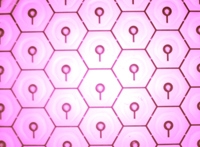Home > Press > Make Brighter, Full-Color Electronic Readers? — Brilliant!
 |
Abstract:
Electrofluidic Display Technology developed at the University of Cincinnati puts electronic book readers ahead by a wide margin.
For the first time "e-paper" will achieve the brilliance of printed media, as described in the May issue of "Nature Photonics."
Make Brighter, Full-Color Electronic Readers? — Brilliant!
Cincinnati, OH | Posted on May 1st, 2009Thinking about getting an e-reader but not sure if you like reading the dim screen? An international collaboration of the University of Cincinnati, Sun Chemical, Polymer Vision and Gamma Dynamics has announced Electrofluidic Display Technology (EFD), the first technology to electrically switch the appearance of pigments in a manner that provides visual brilliance equal to conventional printed media.
This new entry into the race for full-color electronic paper can potentially provide better than 85 percent "white-state reflectance," a performance level required for consumers to accept reflective display applications such as e-books, cell-phones and signage.
"If you compare this technology to what's been developed previously, there's no comparison," says developer Jason Heikenfeld, assistant professor of electrical engineering in UC's College of Engineering. "We're ahead by a wide margin in critical categories such as brightness, color saturation and video speed."
This work, which has been underway for several years, has just been published in the paper "Electrofluidic displays using Young-Laplace transposition of brilliant pigment dispersions."
Lead author Heikenfeld explains the primary advantage of the approach.
"The ultimate reflective display would simply place the best colorants used by the printing industry directly beneath the front viewing substrate of a display," he says. "In our EFD pixels, we are able to hide or reveal colored pigment in a manner that is optically superior to the techniques used in electrowetting, electrophoretic and electrochromic displays."
Because the optically active layer can be less than 15 microns thick, project partners at PolymerVision see strong potential for rollable displays. The product offerings could be extremely diverse, including electronic windows and tunable color casings on portable electronics.
Furthermore, because three project partners are located in Cincinnati (UC, Sun Chemical, Gamma Dynamics), technology commercialization could lead to creation of numerous high-tech jobs in southwest Ohio.
To expedite commercialization, a new company has been launched: Gamma Dynamics with founding members of this company being John Rudolph as president (formerly of Corning), a world-recognized scientist as CTO (who cannot be announced until July), and Heikenfeld as principal scientist.
"This takes the Amazon Kindle, for example, which is black and white, and could make it full color," Heikenfeld says. "So now you could take it from a niche product to a mainstream product."
Funding for this work was provided by Sun Chemical, PolymerVision, the National Science Foundation and the Air Force Research Laboratory.
####
For more information, please click here
Contacts:
Wendy Beckman
Phone: (513) 556-1826
Copyright © University of Cincinnati
If you have a comment, please Contact us.Issuers of news releases, not 7th Wave, Inc. or Nanotechnology Now, are solely responsible for the accuracy of the content.
| Related News Press |
News and information
![]() Researchers develop molecular qubits that communicate at telecom frequencies October 3rd, 2025
Researchers develop molecular qubits that communicate at telecom frequencies October 3rd, 2025
![]() Next-generation quantum communication October 3rd, 2025
Next-generation quantum communication October 3rd, 2025
![]() "Nanoreactor" cage uses visible light for catalytic and ultra-selective cross-cycloadditions October 3rd, 2025
"Nanoreactor" cage uses visible light for catalytic and ultra-selective cross-cycloadditions October 3rd, 2025
Display technology/LEDs/SS Lighting/OLEDs
![]() Spinel-type sulfide semiconductors to operate the next-generation LEDs and solar cells For solar-cell absorbers and green-LED source October 3rd, 2025
Spinel-type sulfide semiconductors to operate the next-generation LEDs and solar cells For solar-cell absorbers and green-LED source October 3rd, 2025
Govt.-Legislation/Regulation/Funding/Policy
![]() New imaging approach transforms study of bacterial biofilms August 8th, 2025
New imaging approach transforms study of bacterial biofilms August 8th, 2025
![]() Electrifying results shed light on graphene foam as a potential material for lab grown cartilage June 6th, 2025
Electrifying results shed light on graphene foam as a potential material for lab grown cartilage June 6th, 2025
![]() Institute for Nanoscience hosts annual proposal planning meeting May 16th, 2025
Institute for Nanoscience hosts annual proposal planning meeting May 16th, 2025
Discoveries
![]() Researchers develop molecular qubits that communicate at telecom frequencies October 3rd, 2025
Researchers develop molecular qubits that communicate at telecom frequencies October 3rd, 2025
![]() Next-generation quantum communication October 3rd, 2025
Next-generation quantum communication October 3rd, 2025
![]() "Nanoreactor" cage uses visible light for catalytic and ultra-selective cross-cycloadditions October 3rd, 2025
"Nanoreactor" cage uses visible light for catalytic and ultra-selective cross-cycloadditions October 3rd, 2025
Announcements
![]() Rice membrane extracts lithium from brines with greater speed, less waste October 3rd, 2025
Rice membrane extracts lithium from brines with greater speed, less waste October 3rd, 2025
![]() Researchers develop molecular qubits that communicate at telecom frequencies October 3rd, 2025
Researchers develop molecular qubits that communicate at telecom frequencies October 3rd, 2025
![]() Next-generation quantum communication October 3rd, 2025
Next-generation quantum communication October 3rd, 2025
![]() "Nanoreactor" cage uses visible light for catalytic and ultra-selective cross-cycloadditions October 3rd, 2025
"Nanoreactor" cage uses visible light for catalytic and ultra-selective cross-cycloadditions October 3rd, 2025
|
|
||
|
|
||
| The latest news from around the world, FREE | ||
|
|
||
|
|
||
| Premium Products | ||
|
|
||
|
Only the news you want to read!
Learn More |
||
|
|
||
|
Full-service, expert consulting
Learn More |
||
|
|
||








